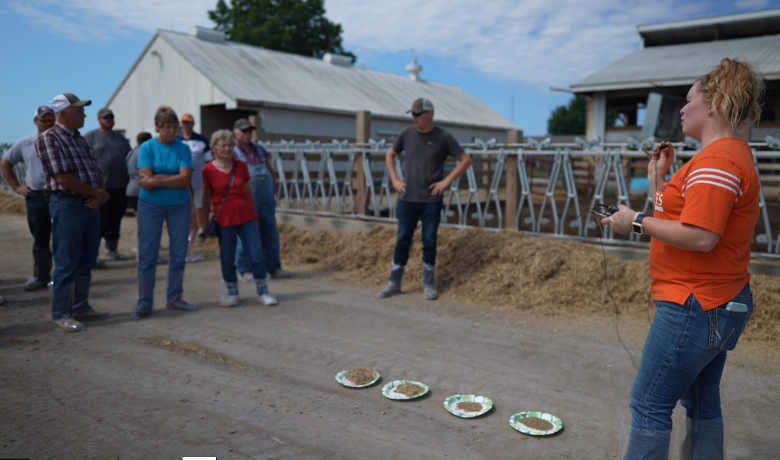Dr. Phil Cardoso, Associate Professor
September, 2022
Straw or other roughage in the dry cow diet must be consumed in the desired amounts. If cows sort out the straw, they will consume too much energy from the other ingredients, which may be poor. In July, during the Dairy Tech Tour hosted by Beer’s Robo Holsteins Dairy Farm near Mascoutah in St. Clair County, we saw a controlled-energy diet for dry cows in action. Mark and Marvin mentioned that since the adoption of this diet, the number of ketosis cases had reduced tremendously. Keeping up with a good mixed diet is not easy. Marvin mentioned that, because of the tour, he did not have enough time to process the straw in the mixer on that day. He mixed it for 5 minutes instead of 20 minutes. We could fix that by using the Penn State Particle Separator on the dry cow TMR. There were four sieves: upper (19-mm pore size), middle (8-mm pore size), lower (4-mm pore size) sieves, and the pan. The upper sieve caught around 54% of the material on that day. The upper sieve caught more material than the middle sieve. This is characteristic of wheat straw that has not been well processed by the mixer. Usually, you should shoot for the prepartum TMR with 6.1 ± 3.0% of material on the upper sieve, 47.8 ± 5.3% on the middle, 20.0 ± 3.0% on the lower sieves, and 26.1 ± 6.7% in the pan.
Much research suggests that short-chopping forages will result in not only greater dry matter intake (DMI) but may also help reduce the amount of feed sorting in lactating cow and dry cow diets. Researchers from Canada reported that cows fed a high-straw dry cow diet with a smaller straw particle size (chopped with a 1-inch screen) had improved intake during the dry period, sorted feed less, and maintained more consistent intake in the week leading up to calving compared to the longer straw (chopped with a 4-inch screen). Another area of concern is the physical difference between a high-straw, lesser moisture dry cow ration and a more dense, greater moisture lactating ration. Controlled-energy dry cow diets typically contain a high proportion of dry forages and thus have lower moisture content than most lactating diets. Researchers in Canada have found that addition of water to lactating cow rations that are low in moisture has been demonstrated to have some beneficial effects, including reduced sorting and resultant greater milk fat content (Leonardi et al., 2005). They also reported that increasing the moisture content of a high-straw dry cow diet (from 53% to 45% dry matter) through water addition, improved DMI during the dry period, resulted in less sorting of that diet, and maintained more consistent DMI in the week leading up to calving. Talk with your nutritionist, veterinarian, and dairy consultant about how to formulate your dry cows’ diet for controlled energy to improve performance. We’re glad to join the conversation.

MS student Emily O’Meara in the transition cow station

